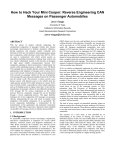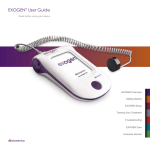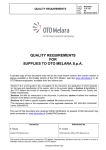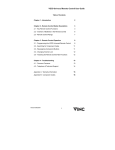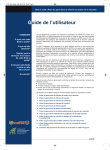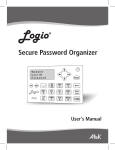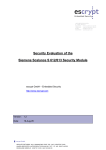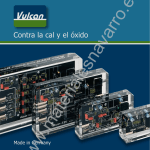Download Side-Channel Analysis
Transcript
Analysis of Performing Secure Remote Vehicle Diagnostics
Dennis Kengo Oka1
Takahiro Furue1
Camille Vuillaume1
Stephanie Bayer2
1
ETAS K.K.
Queen’s Tower C-17F, 2-3-5, Minatomirai, Nishi-ku, Yokohama, Kanagawa, 220-6217 Japan
{dennis-kengo.oka, fixed-term.Takahiro.Furue, Camille.Vuillaume}@etas.com
2
ESCRYPT GmbH
Leopoldstr. 244, 80807 München, Germany
[email protected]
Abstract Traditionally, diagnostics of vehicles is done by plugging a physical device into
a diagnostics interface in the vehicle; however, over the last years OEMs are considering to
perform remote diagnostics. But connecting remotely to a vehicle opens a new entrypoint for
attackers. Hence, it is important to secure the remote diagnostics procedure. We first provide an
analysis of the security properties for remote diagnostics; this is done by giving a short overview
over possible attacks. Next, we analyze and group diagnostic services and specify whether they
are possible or suitable to be performed remotely. Last, we identify relevant security properties
for each of the suitable diagnostic service groups.
1
Introduction
Modern vehicles are equipped with several
dozen electronic control units (ECUs) that are
responsible for the majority of functionality in
a vehicle. ECUs often use sensor values as
inputs which are processed by the ECUs software which in turn render outputs on actuators. For example, the airbag receives sensor
values such as wheel speed, brake, impact, seat
belt status and passenger position. Based on
these sensor values, airbags situated on different places in the car can be inflated at different times at different rates to reduce the likelihood of injuries in crashes and decrease the
likelihood of airbag-related injuries. Software
is run on the ECUs to control such functionality. In addition, the software also monitors
the vehicle or ECU conditions and can provide information regarding vehicle trouble. In
such cases, diagnostic trouble codes (DTCs)
are typically set on the corresponding ECUs.
During vehicle maintenance, dealer workshops
would then investigate the vehicle trouble based
on the set DTCs, which are extracted using
various diagnostics commands. It is important
for OEMs to be able to perform this type of
diagnostics to identify problems with software
or vehicle components as well as calibrate and
test functionality.
Currently, in case of vehicle trouble, vehicle
owners typically need to bring their vehicle to
a dealer workshop where a technician physically plugs an external test equipment tool
(i.e., a diagnostics tool) into the OBD-II port
in the vehicle. The technician can then send
various diagnostic commands from the diagnostic tool which could be a standalone hardware tool or software running on a PC. The
technician uses the diagnostic data extracted
from the vehicle to analyze the problem. The
solution to the problem could for example be a
software update or replacement of a hardware
component.
Unfortunately, there are a few issues with
this approach. One, the technician can only
start the analysis once the vehicle arrives at
the dealer workshop, which leaves the technician little actual time to perform the analysis,
prepare any spare parts that are necessary and
perform any replacements or software updates.
Second, the vehicle owner typically has to wait
for the technician to finish the work before the
vehicle is returned, which causes inconvenience
for the vehicle owner. Third, OEMs can only
collect information about vehicle troubles and
other types of data once the vehicle arrives at
the dealer workshop. The data extracted from
the vehicle is uploaded to the OEM servers
from the technician diagnostic tool. To remedy the issues with this approach, the trend
is to perform remote diagnostics. Remote diagnostics allows reading out DTCs and other
diagnostic data from vehicles remotely (using
for example the telematics module equipped
on vehicles). Consequently, it would address
the three issues above respectively. One, the
technician can perform part of the work prior
to the vehicle even arriving at the dealer workshop. That is, the technician can first perform
remote diagnostics to extract data necessary
for the analysis and perform the analysis in
advance. The technician can also prepare any
necessary spare parts. When the vehicle is
available at the dealer workshop, the technician can immediately start working based on
the results of the analysis that has been made
beforehand and replace any components using
the prepared spare parts. Second, the wait
time for the vehicle owner has been reduced
to only the actual work needed to do the replacements or software updates, which means
the happy vehicle owner will be back on the
streets much faster. Third, OEMs can continuously collect diagnostic data which contain
information about vehicle troubles and other
types of data. This allows OEMs to analyze a
larger set of data much sooner and would help
in identifying any failure trends and in preparing to handle any large-scale vehicle trouble incidents as well as improving existing software
with new features much quicker.
To allow remote diagnostics, security is necessary. For example, only authorized parties
should be allowed to perform remote diagnostics. Moreover, some diagnostic commands
may be considered too dangerous or not useful
to perform remotely.
In this paper, we make the following contributions:
• We provide an analysis of the security properties for remote diagnostics.
• We analyze and group diagnostic services
and specify whether they are possible or
suitable to be performed remotely.
• We identify relevant security properties for
the diagnostic service groups that are suitable to be performed remotely.
2
Remote Diagnostics Overview
In the following, we provide an overview of
the remote diagnostics use case.
2.1
Definition of remote diagnostics
The term remote diagnostics may be interpreted differently by different people so first
we provide a definition to ensure a common
view of the use case.
Definition In the remote diagnostics use case,
there is no physical connection between the diagnostics tool and the vehicle (i.e., communication between diagnostics tool and vehicle is
wireless), and the technician has no physical
access to the vehicle and cannot perform any
physical actions on the vehicle.
2.2
Overview of remote diagnostics
use case
An overview of the remote diagnostics use
case is described as follows. Modern vehicles
are equipped with telematics modules that connect the vehicles to the Internet. The telematics module also serves as a gateway between
the Internet connection and the in-vehicle network (e.g., CAN bus). A diagnostics command
is sent from the OEM server over the Internet
and received in the target vehicle. The diagnostics command could have originated from
an OEM technician (e.g., to perform data collection), or a dealer technician (e.g., to perform diagnostics on a vehicle prior to arriving
at the workshop). The diagnostics command is
transmitted on the relevant bus and processed
by the target ECU in the vehicle. The result
is returned via the telematics module to the
OEM server. We consider the communication
channel between the OEM technician/dealer
technician and the OEM server to be secured
using traditional IT security means.
The ISO 14229 [1] provides the standard for
unified diagnostics services (UDS). The standard defines a number of diagnostics services
where a diagnostic tool can control diagnostic
functions in an ECU. For example, there are
services such as changing the diagnostic session, resetting the ECU and reading or writing data to the ECU. Although the ISO 14229
standard also covers ECU programming, we
have chosen to separate ECU programming
from the remote diagnostics use case as it is
very different from the rest of the diagnostics
services and serves a different purpose (i.e., not
used to diagnose a vehicle but rather to “fix”
an issue by updating the software).
• The attacker can inject, modify or listen to
any messages in the communication channel between the OEM server and telematics module on the vehicle.
• The attacker has physical access to the vehicle and can inject, modify or listen to
any messages in the communication channel between the telematics module and the
target ECUs.
As a result, rather than considering to pointto-point secure two separate communication
channels (between OEM server and telematics
module, and between telematics module and
target ECUs), we only consider securing the
end-to-end communication channel (between
originator (OEM technician/dealer technician)
and target ECUs). Although the focus is on
securing the end-to-end communication channel, some messages in transit could be encapsulated in a lower-level protocol that may already provide some additional security features.
2.4
We analyze the remote diagnostics use case
and consider the following security properties
desirable. A simplistic view of secure remote
diagnostics would only consider to secure the
communication channel between the OEM server
and the telematics module because what happens between the telematics module and the
target ECU is similar to the existing diagnostics use case today (between the ODB-II port
and the target ECU). However, in this paper
we consider securing the end-to-end communication channel and therefore consider the appropriate security properties for this channel.
2.4.1
2.3
Security properties
Authenticity
Attacker model
The attacker model in the remote diagnostics use case is defined as follows:
One important security property is authenticity. It is paramount to ensure that a diagnostic message is actually coming from the
correct entity and has not been spoofed. That
is, the receiving entity needs to be able to
properly verify that a message comes from the
claimed originator.
Researchers [2, 3, 4] have shown cases where
they have broken the simple seed-key authentication that is implemented for diagnostic access in some vehicles. Even worse, some cases
seem to be not employing any authentication
at all or use fixed keys. Researchers have shown
that they can execute arbitrary diagnostics commands to control the ECUs or read out the
memory from the ECUs.
3
In this section we analyze and breakdown
diagnostics services into groups and identify
which are possible/suitable to perform remotely
and which are not. We deem the groups that
are not suitable to be performed remotely as
not allowed to be performed remotely. We
also identify the relevant security properties
for each group that is suitable to be performed
remotely.
3.1
2.4.2
Integrity
Analysis of Secure Remote
Diagnostics
Diagnostics breakdown
Common vehicle diagnostics tools provide a
plethora of diagnostics capabilities [5, 6, 7, 8,
Integrity is equally important as authentic9, 10, 11, 12, 13, 14, 15, 16, 17]. We use these
ity. It is imperative that messages that are
capabilities as a basis for our analysis. Differsent between the communicating parties have
ent tool manufacturers and OEMs use slightly
not been modified while in transit. If mesdifferent terminology for the various diagnossages can be modified, an attacker could modtics capabilities. Although terminology may
ify requests sent from the OEM server to exebe different, we believe that the respective cacute commands other than the intended ones
pabilities can be assigned into one of the cator prevent a vehicle with vehicle trouble from
egories in our summary breakdown shown in
going to a dealer workshop by modifying the
trouble-indicating responses with responses that Table 1.
First, we breakdown the diagnostics procethe vehicle is fine.
dure itself into two categories: Passive and
Active. The definition for passive is no phys2.4.3 Confidentiality
ical action on the vehicle by the technician is
necessary. Conversely, the definition for active
There exist manufacturer specific diagnostic
is requires physical action on the vehicle by the
commands and responses which OEMs would
technician. Physical action is defined as physprefer to keep secret. Moreover, some of the
ical
input or physical inspection (e.g., visual).
data collected from vehicles may contain senIn no cases is the vehicle user required to be
sitive information. Therefore, for such data
involved.
there is a need to provide confidentiality in
At the next level, there are three categories:
the communication channel. If an attacker is
Read, Clear and Function test. Read indicates
able to sniff the traffic, secret or sensitive data
any diagnostics that comprises reading data
could be leaked; for example, secret diagnosfrom an ECU. Clear represents clear DTCs.
tics commands or data related to the privacy
Function test covers all function tests.
of the vehicle owner.
The last level shows the individual groups of
diagnostics which are further explained separately in below sections. The analysis and the
Datalist
Table 1: Breakdown of diagnostics into groups
Diagnostics
Passive
Active
Read
Clear
Function test
Function test
DTC Freezeframe DTC Inspection Adjustment Inspection Adjustment
decision whether a diagnostics group is possible to be performed remotely is based on the
actions required to perform the functions in
the group. Moreover, some vehicles may require that a battery charger is connected to
the vehicle or ensuring that the ignition key
is in the on position with the engine off for
some of the functions in the group to be executed. However, the purpose of this breakdown is to provide an overview of the groups
and therefore does not go into all the details
necessary for individual actions or tests within
each group.
The results of the analysis are summarized
in Table 2. For diagnostics groups that are not
suitable (i.e., not allowed) to be performed remotely, no specific security properties are identified as they are not applicable (N/A).
3.1.1
Passive - Read datalist
This group is passive and consists of reading data from the ECU and displaying the values to a technician. These values are used
to understand the current status or condition
of the ECUs. Example values include vehicle speed, engine RPM, engine coolant temperature, open/close status of valves and gear
position. Furthermore, reading law-mandated
vehicle emission-related data (OBD-II PIDs)
from the ECU is considered a subset of reading
values from datalist, DTCs and freezeframes
(DTCs and freezeframes described in the following subsections) and is therefore not considered as a separate group. Standard OBD-II
PIDs are defined in SAE J1979 [18].
This group is both possible and suitable to
perform remotely as it purely reads data from
the ECUs and does not affect the function of
the ECUs or require any active physical action
by the technician.
This group requires the security properties
authenticity and integrity and depending on
the type of data that is read confidentiality
may be required.
3.1.2
Passive - Read DTCs
This group is passive and consists of reading
data from the ECU and displaying the values
to a technician. The purpose of reading DTCs
is to understand what could be “wrong” with
a specific ECU or the vehicle and to assist in
identifying the cause of vehicle trouble. Examples of DTCs are sensor circuit malfunction, injector circuit malfunction and cylinder
1 misfire detected.
This group is both possible and suitable to
perform remotely as it purely reads data from
the ECUs and does not affect the function of
the ECUs or require any active physical action
by the technician.
This group requires the security properties
authenticity and integrity and depending on
the type of data that is read confidentiality
may be required.
3.1.3
Passive - Read freezeframe
This group is passive and consists of reading
data from the ECU and displaying the values
to a technician. When a fault occurs and a
DTC is set, the ECU records the conditions
present when the fault occurred and stores it
3.1.5 Passive - Inspection function tests
as a freezeframe. For example, the conditions
This group is passive and includes function
recorded could include fuel system status, the
tests that are used for inspection. Typically
coolant temperature and engine RPM. The freezethis group includes tests that change a value
frame data helps the technician to understand
which then can be inspected by checking the
the conditions of the ECU when the DTC ocstatus or by reading a specific value. These
curred to assist in troubleshooting the probtests could also be self-tests. For example,
lem.
check or toggle valve open/close or perform
This group is both possible and suitable to
solenoid test. This group is used for testing inperform remotely as it purely reads data from
dividual functionality by inspecting (i.e., readthe ECUs and does not affect the function of
ing a value) that the correct behavior is occurthe ECUs or require any active physical action
ring.
by the technician.
This group is both possible and suitable to
This group requires the security properties
perform remotely although it does make changes
authenticity and integrity and depending on
to the ECUs, it does not require any active
the type of data that is read confidentiality
physical action by the technician. The inspecmay be required.
tion can be performed remotely by reading out
the relevant data. N.B. there might exist some
3.1.4 Passive - Clear DTCs
tests that require the vehicle to be in a certain
state, e.g., vehicle speed 0 or gear in park. It
This group is passive but rather than readis assumed that the vehicle will be in this state
ing data from the ECU it makes changes to
at some point naturally, and thus does not rethe ECU by clearing or erasing DTCs that
quire any physical action.
have been previously set. DTCs are typically
This group requires the security properties
cleared after the corresponding fault has been
authenticity and integrity. If the function test
remedied by for example updating the softcommands need to be kept secret, confidenware on the ECU or replacing the faulty comtiality is also required.
ponent.
This group is possible to perform remotely
although it does make changes to the ECUs,
3.1.6 Passive ‒ Adjustment function
it does not require any active physical action
tests
by the technician (N.B. some vehicles may reThis group is passive and consists of funcquire that the ignition key is in the on position
tion tests that are used for adjustment and
with the engine off). However, the clear DTC
provide support for repair. This group would
function is typically performed after the corcontain tests that allow reset and initialization
responding fault has been remedied and thereof ECUs, or adjust certain parameters. For
fore may not be suitable to be performed reexample, adjusting the height of head lights
motely (unless the issue can be resolved and
or adjusting the tire size would be considered
verified remotely).
passive adjustment tests.
This group requires the security properties
This group is possible to perform remotely
authenticity and integrity. Assuming that the
although it does make changes to the ECUs,
clear DTCs commands are not secret, confiit does not require any active physical action
dentiality is not required.
by the technician. However, typically adjustment function tests would occur in conjunction with actual repair or replacement where
physical access is necessary. Thus, it would
technically be possible to perform these tests
remotely but in practice it would not be suitable.
Since it is not suitable (i.e., not allowed)
to execute the function tests in this group remotely, security properties for this group are
not applicable.
3.1.7
Active ‒ Inspection function tests
This group is active and consists of function
tests that actively change something which a
technician typically can physically inspect. Turning on/off the wipers or the hazard light, locking/unlocking the doors, and moving the power
windows up and down are examples of active
inspection function tests.
This group is not possible nor suitable to
perform remotely because it requires physical
inspection by the technician. It would be possible to execute the first half of the test which
is for the vehicle to perform an action but the
second half of the test requires a physical action in the sense of physical inspection.
Since it is not suitable (i.e., not allowed)
to execute the function tests in this group remotely, security properties for this group are
not applicable.
the very far left position and then back to the
very far right position and finally back to the
center position.
This group is not possible nor suitable to
perform remotely as it requires active physical input by the technician. Moreover, typically adjustment function tests would occur in
conjunction with actual repair where physical
access is necessary anyway.
Since it is not suitable (i.e., not allowed)
to execute the function tests in this group remotely, security properties for this group are
not applicable.
4
Conclusion
As vehicle diagnostics was traditionally done
over a cable (i.e., a wired connection), there
was no need to separate or define diagnostics groups other than for the purpose of organizing the diagnostics functions to ease the
technicians’ job to perform the actual diagnostics. For example, to easily find the desired
functions in the diagnostics tool, the functions
are grouped and typically displayed under corresponding menus. However, in allowing remote diagnostics, there is an important need
to define diagnostics into various groups with
specific requirements. OEMs need to determine which diagnostics functions are allowed
or suitable to be performed remotely. For the
diagnostics groups that are allowed to be performed remotely, proper security requirements
3.1.8 Active ‒ Adjustment function tests and solutions need to be implemented. As
future work, we will investigate such requireThis group is active and includes function
ments and suggest a suitable implementation
tests that are used for adjustment and prooption.
vide support for repair. This group comprises
Secure remote diagnostics will provide OEMs
tests that allow calibration of sensors, camwith multiple new business models and will aleras or steering and as well as various learnlow increasing the efficiency to diagnose faulty
ing tests. For example, an active adjustment
vehicles as well as reducing the waiting time
function test would be the steering end learnfor the vehicle owner.
ing where a technician physically has to turn
the steering wheel from the center position to
Table 2: Summary of diagnostics groups and whether they are possible/suitable to be performed
remotely and respective security properties
Group
Passive - Read datalist
Passive - Read DTC
Passive - Read freezeframe
Passive - Clear DTC
Passive - Inspection function tests
Passive - Adjustment function tests
Active - Inspection function tests
Active - Adjustment function tests
1
2
Possible
remotely
Yes
Yes
Yes
Yes
Yes
Yes
No
No
Suitable
remotely
Yes
Yes
Yes
Yes2
Yes
No
No
No
Security properties
A
I
C
⃝
⃝
△
⃝
⃝
△
⃝
⃝
△
⃝
⃝
×
⃝
⃝
△
N/A N/A N/A
N/A N/A N/A
N/A N/A N/A
1
A: Authenticity, I: Integrity, C: Confidentiality, ⃝: Required, △: Required if transmitted
data need to be kept secret, ×: Not required, N/A: Not applicable
If issue can be resolved remotely yes, otherwise no.
References
[1] ISO 14229-1 Road vehicles - Unified diagnostic services (UDS) - Part 1: Specification and requirements, 2013.
[2] K. Koscher, A. Czeskis, F. Roesner,
S. Patel, T. Kohno, S. Checkoway, D.
McCoy, B. Kantor, D. Anderson, H.
Shacham, and S. Savage “Experimental
Security Analysis of a Modern Automobile”, IEEE Symposium on Security and
Privacy, 2010.
[3] S. Checkoway, D. McCoy, B. Kantor, D.
Anderson, H. Shacham, S. Savage, K.
Koscher, A. Czeskis, F. Roesner, and
T. Kohno “Comprehensive Experimental Analyses of Automotive Attack Surfaces”, USENIX conference on Security,
2011.
[4] Charlie Miller, Chris Valasek “Adventures in Automotive Networks and Control Units”, DEFCON 21, 2013.
[5] Autologic Diagnostics “Autologic Software Technical Specifications for BMW
Vehicles”, 2013.
[6] Craftsman “CanOBD2 Diagnostic Tool
Operator’s Manual”, 2008.
[7] Snap-on “Solus PRO User Manual”,
2012.
[8] Innova Electronics Corp. “CanOBD2
ScanTool Owner’s Manual”, 2008.
[9] Gore Research “ProScan”, 2006.
[10] Banzai “MST2000”, 2014
[11] GIT “G-scan User Manual”, 2012
[12] OTC “Genisys User Guide”, 2005.
[13] SPX “Modular Vehicle Communication
Interface (MVCI) User Guide”, 2010.
[14] Ford Motor Company “Integrated Diagnostic Software User’s Guide”, 2008.
[15] EASE Diagnostics “EASE PC Scan
Tool”, 2012.
[16] Nissan TechNews “Consult III plus,
CAN, ECU Programming”, 2011.
[17] Motor “Scan Tool Assessment”, 2005
[18] SAE J1979: E/E Diagnostic Test Modes,
2012.










